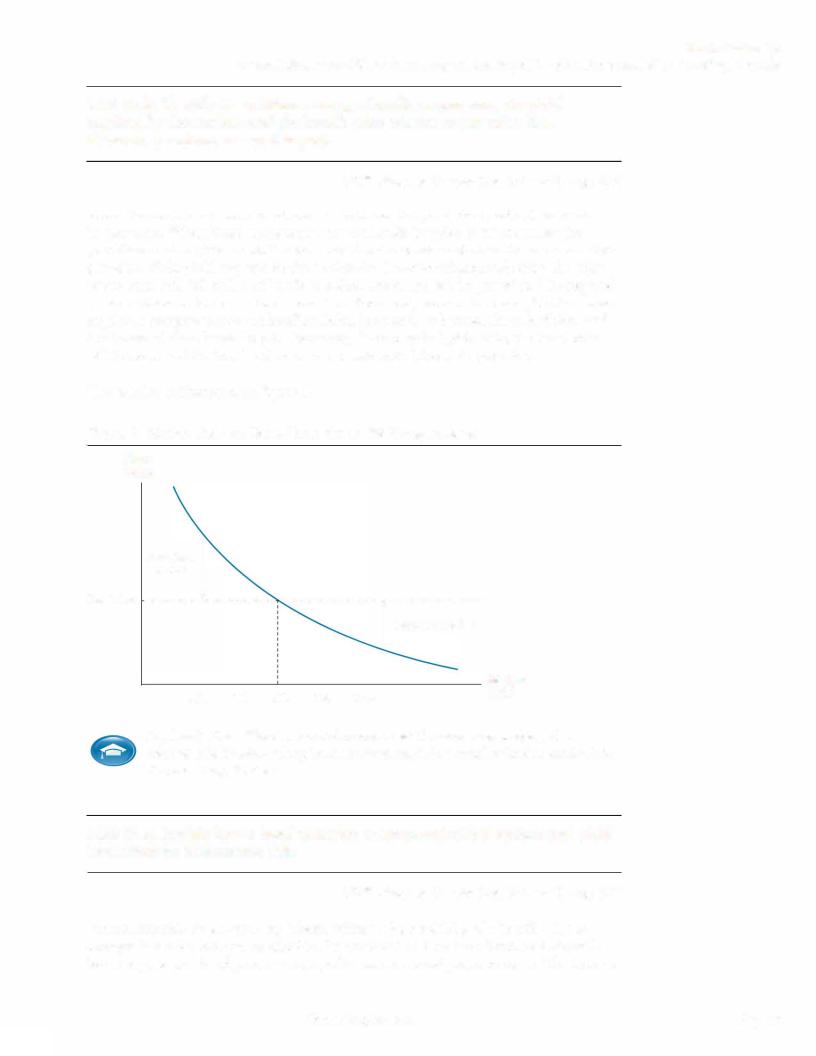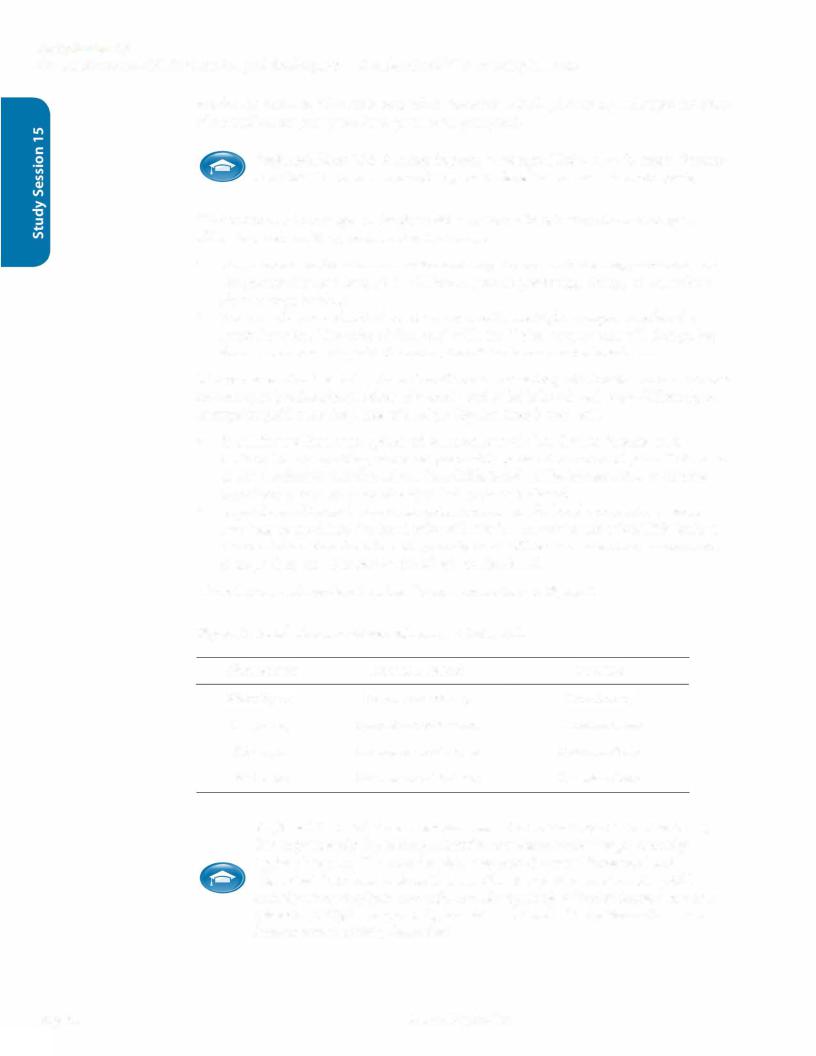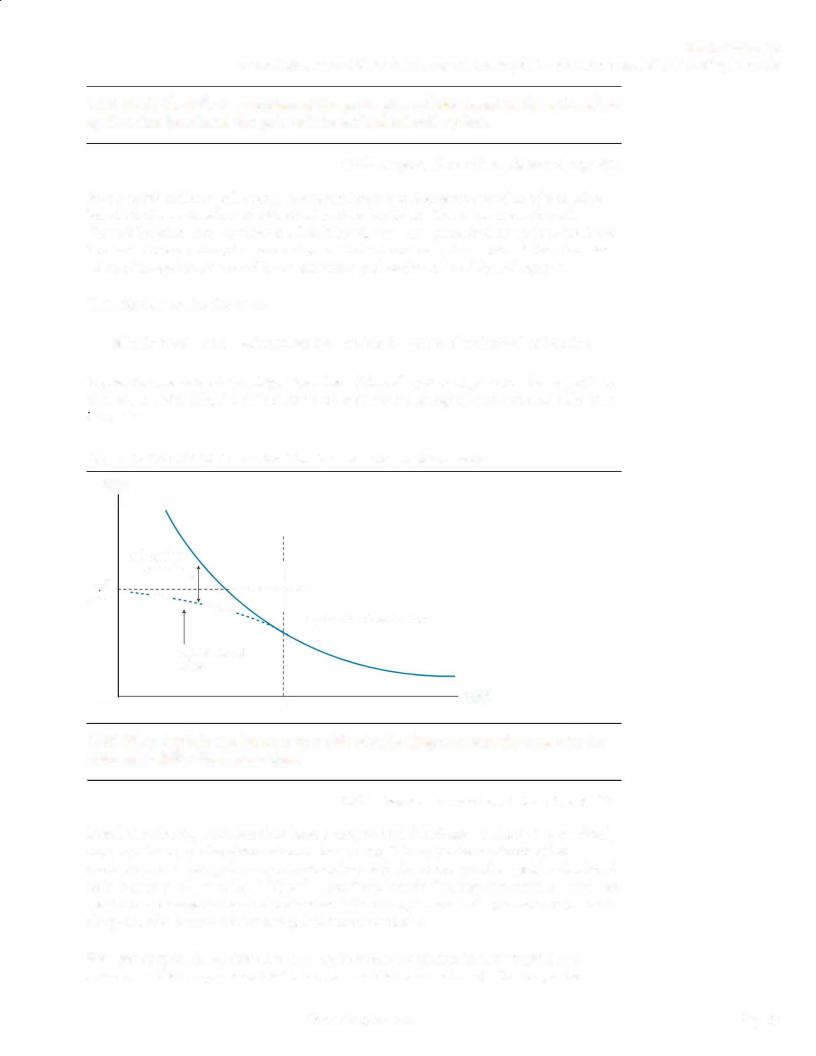
2013 CFA Level 1 - Book 5
.pdf
Study Session 1 5
Cross-Reference to CFA Institute Assigned Reading #52 - Features of Debt Securities
LOS 52.d |
|
Bond retirement (payoff) provisions: |
|
• |
Amortizing securities make periodic payments that include both interest and |
|
principal payments so that the entire principal is paid offwith the last payment |
|
unless prepayment occurs. |
• |
A prepayment option is contained in some amortizing debt and allows the borrower |
|
to pay off principal at any time prior to maturity, in whole or in part. |
• |
Sinking fund provisions require that a part of a bond issue be retired at specified |
|
dates, typically annually. |
• |
Call provisions enable the borrower (issuer) to buy back the bonds from the |
|
investors (redeem them) at a call price(s) specified in the bond indenture. |
• |
Callable but nonrefundable bonds can be called prior to maturity, but their |
|
redemption cannot be funded by the issuance of bonds with a lower coupon rate. |
LOS 52.e |
|
Embedded options that benefit the issuer reduce the bond's value (increase the yield) to |
|
a bond purchaser. Examples are: |
|
• |
Call provisions. |
• |
Accelerated sinking fund provisions. |
• |
Caps (maximum interest rates) on floating-rate bonds. |
|
|
Embedded options that benefit bondholders increase the bond's value (decrease the |
|
yield) to a bond purchaser. Examples are: |
|
• |
Conversion options (the option of bondholders to convert their bonds into shares of |
|
the bond issuer's common stock). |
• |
Put options (the option of bondholders to return their bonds to the issuer at a |
|
predetermined price). |
• |
Floors (minimum interest rates) on floating-rate bonds. |
|
LOS 52.f
Institutions can finance secondary market bond purchases by margin buying (borrowing some of the purchase price, using the securities as collateral) or, more commonly, by repurchase (repo) agreements, an arrangement in which an institution sells a security with a promise to buy it back at an agreed-upon higher price at a specified date in the future.
Page 20 |
©2012 Kaplan, Inc. |

Study Session 1 5
Cross-Reference to CFA Institute Assigned Reading #52 - Features ofDebt Securities
CONCEPT CHECKERS
1 .
2.
3 .
4.
5 .
6.
7.
A bond's indenture:
A. contains its covenants.
B. is the same as a debenture.
C. relates only to its interest and principal payments.
A bond has a par value of $5 ,000 and a coupon rate of 8.5% payable semiannually. What is the dollar amount of the semiannual coupon payment? A. $212.50.
B. $238.33. c. $425.00.
From the perspective of the bondholder, which of the following pairs of options would add value to a straight (option-free) bond?
A. Call option and conversion option. B. Put option and conversion option. C. Prepayment option and put option.
A 10-year bond pays no interest for three years, then pays $229.25, followed by payments of $35 semiannually for seven years and an additional $ 1 ,000 at maturity. This bond is a:
A. step-up bond.
B. zero-coupon bond.
C. deferred-coupon bond.
Consider a $ 1 million semiannual-pay, floating-rate issue where the rate is reset |
|
on January 1 and July 1 each year. The reference rate is 6-month LIBOR, and |
|
the stated margin is + 1.25%. If 6-month LIBOR is 6.5% on July 1 , what will |
|
the next semiannual coupon be on this issue? |
|
A. |
$38,750. |
B. |
$65,000. |
c. |
$77,500. |
Which of the following statements is most accurate with regard to floating-rate issues that have caps and floors?
A. A cap is an advantage to the bondholder, while a floor is an advantage to the iSSUer.
B. A floor is an advantage to the bondholder, while a cap is an advantage to the iSSUer.
C. A floor is an advantage to both the issuer and the bondholder, while a cap is a disadvantage to both the issuer and the bondholder.
An investor paid a full price of $ 1 ,059.04 each for 1 00 bonds. The purchase was between coupon dates, and accrued interest was $23.54 per bond. What is each bond's clean price?
A. $ 1 ,000.00.
B. $ 1 ,035.50. c. $ 1 ,082.58.
©20 12 Kaplan, Inc. |
Page 21 |
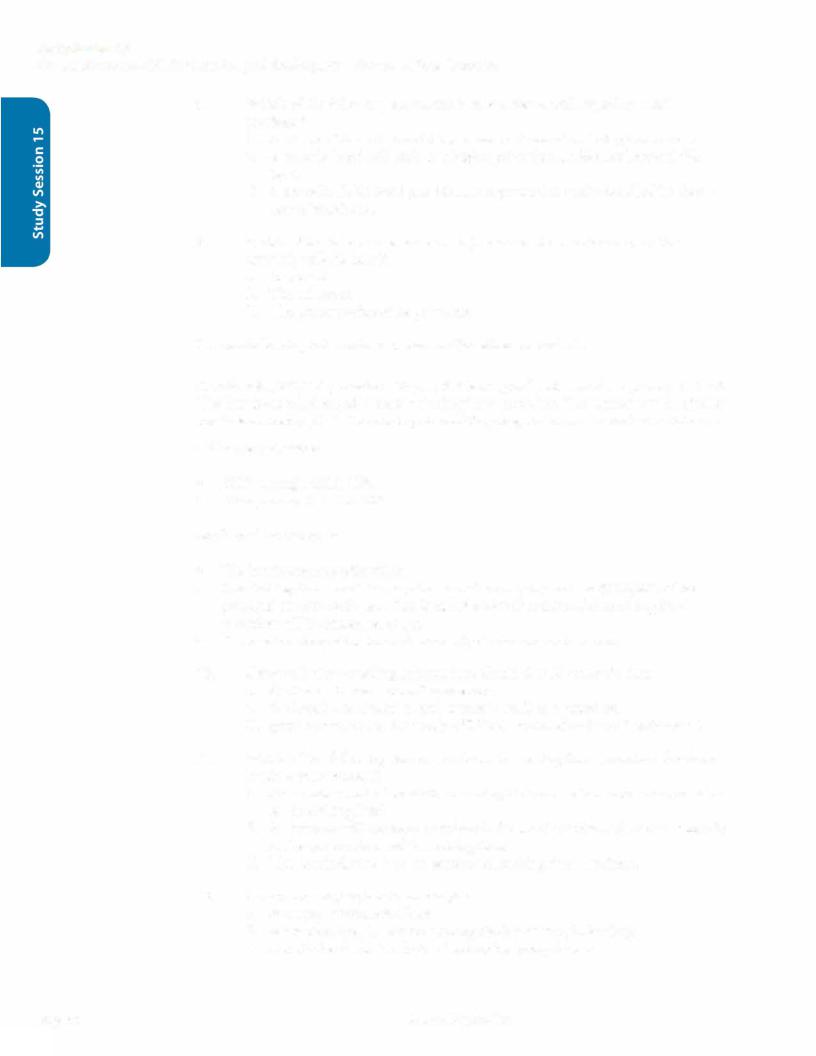
Study Session 1 5
Cross-Reference to CFA Institute Assigned Reading #52 - Features of Debt Securities
8.
9.
Which of the following statements is most accurate with regard to a call provision? A. A call provision will benefit the issuer in times of declining interest rates. B. A callable bond will trade at a higher price than an identical noncallable
bond.
C. A nonrefundable bond provides more protection to the bondholder than a noncallable bond.
Which of the following most accurately describes the maximum price for a currently callable bond?
A. Its par value.
B. The call price.
C. The present value of its par value.
Use the following information to answer Questions 10 and 11.
Consider $ 1 ,000,000 par value, 10-year, 6.5% coupon bonds issued on January 1 , 2005. The bonds are callable and there is a sinking fund provision. The market rate for similar bonds is currently 5.7%. The main points of the prospectus are summarized as follows:
Call dates and prices:
•2005 through 2009: 1 03.
•After January 1 , 2010: 102. Additional information:
•The bonds are non-refundable.
•The sinking fund provision requires that the company redeem $ 100,000 of the principal amount each year. Bonds called under the terms of the sinking fund provision will be redeemed at par.
•The credit rating of the bonds is currently the same as at issuance.
10. |
Using only the preceding information, Gould should conclude that: |
|
|
A. |
the bonds do not have call protection. |
|
B. |
the bonds were issued at and currently trade at a premium. |
1 1 . |
C. |
given current rates, the bonds will likely be called and new bonds issued. |
Which of the following statements about the sinking fund provisions for these |
||
|
bonds is most accurate? |
|
|
A. |
An investor would benefit from having his bonds called under the provision |
|
B. |
of the sinking fund. |
|
An investor will receive a premium ifthe bond is redeemed prior to maturity |
|
|
|
under the provision of the sinking fund. |
12. |
C. The bonds do not have an accelerated sinking fund provision. |
|
An investor buying bonds on margin: |
||
|
A. |
must pay interest on a loan. |
|
B. |
is not restricted by government regulation of margin lending. |
|
C. |
actually lends the bonds to a bank or brokerage house. |
Page 22 |
©2012 Kaplan, Inc. |

13.
14.
Study Session 1 5
Cross-Reference to CFA Institute Assigned Reading #52 - Features ofDebt Securities
Which of the following is least likely a provision for the early retirement of debt by the issuer?
A. A conversion option.
B. A call option.
C. A sinking fund.
A mortgage is least likely:
A. a collateralized loan.
B. subject to early retirement.
C. characterized by highly predictable cash flows.
©20 12 Kaplan, Inc. |
Page 23 |

Study Session 1 5
Cross-Reference to CFA Institute Assigned Reading #52 - Features of Debt Securities
ANSWERS - CONCEPT CHECKERS
1 .
AAn indenture is the contract between the company and its bondholders and contains the bond's covenants.
2. A The annual interest is 8.5% of the $5,000 par value, or $425. Each semiannual payment is one-half of that, or $212.50.
3.B A put option and a conversion option have positive value to the bondholder. The other options favor the issuer and result in a lower value than a straight bond.
4.C This pattern describes a deferred-coupon bond. The first payment of$229.25 is the value of the accrued coupon payments for the first three years.
5. A The coupon rate is 6.5 + 1 .25 = 7.75. The semiannual coupon payment equals (0.5)(0.0775)($1 ,000,000) = $38,750.
6.B A cap is a maximum on the coupon rate and is advantageous to the issuer. A floor is a minimum on the coupon rate and is, therefore, advantageous to the bondholder.
7.B The full price includes accrued interest, while the clean price does not. Therefore, the clean price is 1 ,059.04 - 23.54 = $ 1 ,035.50.
8.A A call provision gives the bond issuer the right to call the bond at a price specified in the bond indenture. A bond issuer may want to call a bond if interest rates have decreased so that borrowing costs can be decreased by replacing the bond with a lower coupon issue.
9.B Whenever the price of the bond increases above the strike price stipulated on the call option, it will be optimal for the issuer to call the bond. So theoretically, the price of a currently callable bond should never rise above its call price.
10. A The bonds are callable in 2005, indicating that there is no period of call protection. We have no information about the pricing of the bonds at issuance. The company may not refond the bonds (i.e., they cannot call the bonds with the proceeds of a new debt offering at the currently lower market yield).
1 1 . C The sinking fund provision does not provide for an acceleration of the sinking fund redemptions. With rates currently below the coupon rate, the bonds will be trading at a premium to par value. Thus, a sinking fund call at par would not benefit a bondholder.
12. A Margin loans require the payment of interest, and the rate is typically higher than funding costs when repurchase agreements are used.
13. A A conversion option allows bondholders to exchange their bonds for common stock. The option is held by the boldholder, not the issuer.
14. C A mortgage can typically be retired early in whole or in part (a prepayment option), and this makes the cash flows difficult to predict with any accuracy.
Page 24 |
©2012 Kaplan, Inc. |
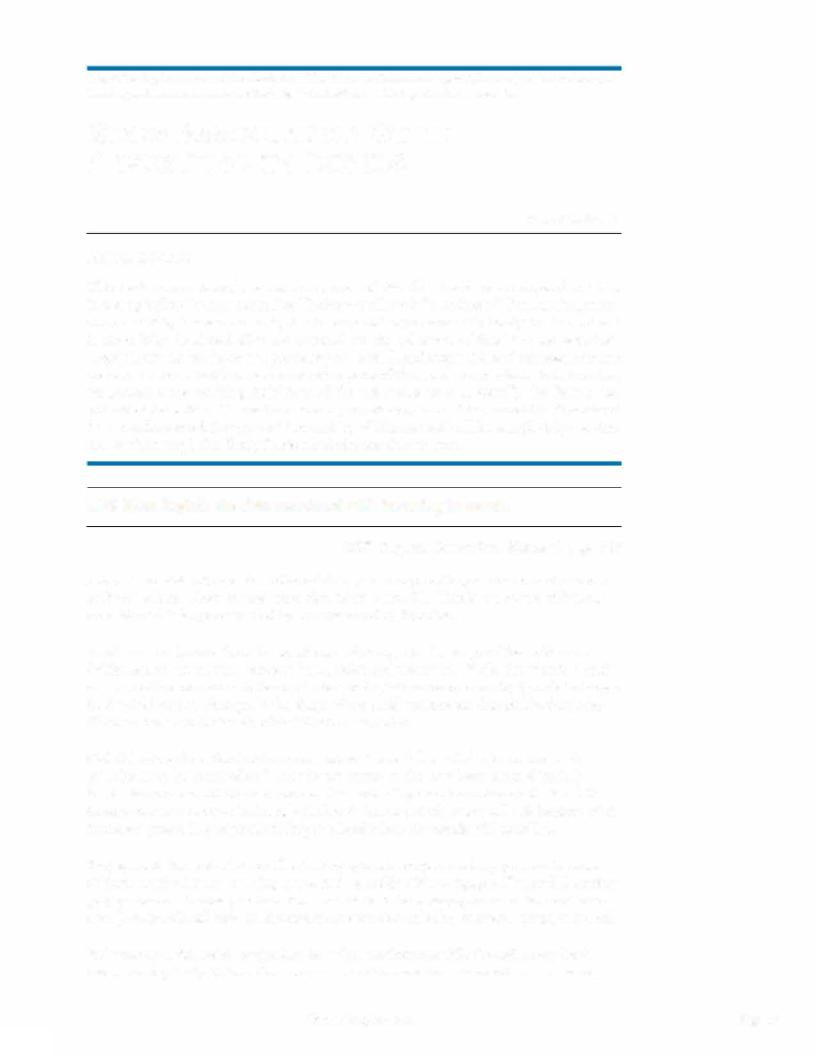
The following is a review ofthe Analysis ofFixed Income Investments principles designed to address the learning outcome statements set forth by CFA Institute. This topic is also covered in:
RISKS ASSOCIATED WITH
INVESTING IN BONDS
Study Session 1 5
EXAM FOCUS
This topic review introduces various sources of risk that investors are exposed to when investing in fixed income securities. The keyword here is "introduces." The most important source of risk, interest rate risk, has its own full topic review in Study Session 1 6 and is more fully developed after the material on the valuation of fixed income securities. Prepayment risk has its own topic review at Level II, and credit risk and reinvestment risk are revisited to a significant extent in other parts of the Level I curriculum. In this review, we present some working definitions of the risk measures and identify the factors that will affect these risks. To avoid unnecessary repetition, some of the material is abbreviated here, but be assured that your understanding of this material will be complete by the time you work through this Study Session and the one that follows.
LOS 53.a: Explain the risks associated with investing in bonds.
CFA® Program Curriculum, Volume 5, page 320
Interest rate risk refers to the effect of changes in the prevailing market rate of interest on bond values. When interest rates rise, bond values fall. This is the source of interest rate risk which is approximated by a measure called duration.
Yield curve risk arises from the possibility of changes in the shape of the yield curve (which shows the relation between bond yields and maturity). While duration is a useful measure of interest rate risk for equal changes in yield at every maturity (parallel changes in the yield curve), changes in the shape of the yield curve mean that yields change by different amounts for bonds with different maturities.
Call risk arises from the fact that when interest rates fall, a callable bond investor's principal may be returned and must be reinvested at the new lower rates. Certainly bonds that are not callable have no call risk, and call protection reduces call risk. When interest rates are more volatile, callable bonds have relatively more call risk because of an increased probability of yields falling to a level where the bonds will be called.
Prepayment risk is similar to call risk. Prepayments are principal repayments in excess of those required on amortizing loans, such as residential mortgages. If rates fall, causing prepayments to increase, an investor must reinvest these prepayments at the new lower rate. Just as with call risk, an increase in interest rate volatility increases prepayment risk.
Reinvestment risk refers to the fact that when market rates fall, the cash flows (both interest and principal) from fixed-income securities must be reinvested at lower rates,
©20 12 Kaplan, Inc. |
Page 25 |

Study Session 1 5
Cross-Reference to CFA Institute Assigned Reading #53 - Risks Associated With Investing in Bonds
reducing the returns an investor will earn. Note that reinvestment risk is related to call risk and prepayment risk. In both of these cases, it is the reinvestment of principal cash flows at lower rates than were expected that negatively impacts the investor. Coupon bonds that contain neither call nor prepayment provisions will also be subject to reinvestment risk, because the coupon interest payments must be reinvested as they are received.
Note that investors can be faced with a choice between reinvestment risk and price risk. A noncallable zero-coupon bond has no reinvestment risk over its life because there are no cash flows to reinvest, but a zero-coupon bond (as we will cover shortly) has more interest rate risk than a coupon bond of the same maturity. Therefore, the coupon bond will have more reinvestment risk and less price risk.
Credit risk is the risk that the creditworthiness of a fixed-income security's issuer will deteriorate, increasing the required return and decreasing the security's value.
Liquidity risk has to do with the risk that the sale of a fixed-income security must be made at a price less than fair market value because of a lack of liquidity for a particular issue. Treasury bonds have excellent liquidity, so selling a few million dollars worth at the prevailing market price can be easily and quickly accomplished. At the other end of the liquidity spectrum, a valuable painting, collectible antique automobile, or unique and expensive home may be quite difficult to sell quickly at fair-market value. Since investors prefer more liquidity to less, a decrease in a security's liquidity will decrease its price, as the required yield will be higher.
Exchange-rate risk arises from the uncertainty about the value of foreign currency cash flows to an investor in terms of his home-country currency. While a U.S. Treasury bill (T-bill) may be considered quite low risk or even risk-free to a U.S.-based investor, the value of the T-bill to a European investor will be reduced by a depreciation of the
U.S. dollar's value relative to the euro.
Inflation risk might be better described as unexpected inflation risk and even more descriptively as purchasing-power risk. While a $ 10,000 zero-coupon Treasury bond can provide a payment of $ 10,000 in the future with near certainty, there is uncertainty about the amount of goods and services that $ 10,000 will buy at the future date. This uncertainty about the amount of goods and services that a security's cash flows will purchase is referred to here as inflation risk.
Volatility risk is present for fixed-income securities that have embedded options, such as call options, prepayment options, or put options. Changes in interest rate volatility affect the value of these options and, thus, affect the values of securities with embedded options.
Event risk encompasses the risks outside the risks of financial markets, such as the risks posed by natural disasters and corporate takeovers.
Sovereign risk is essentially the credit risk of a sovereign bond issued by a country other than the investor's home country.
Page 26 |
©2012 Kaplan, Inc. |
